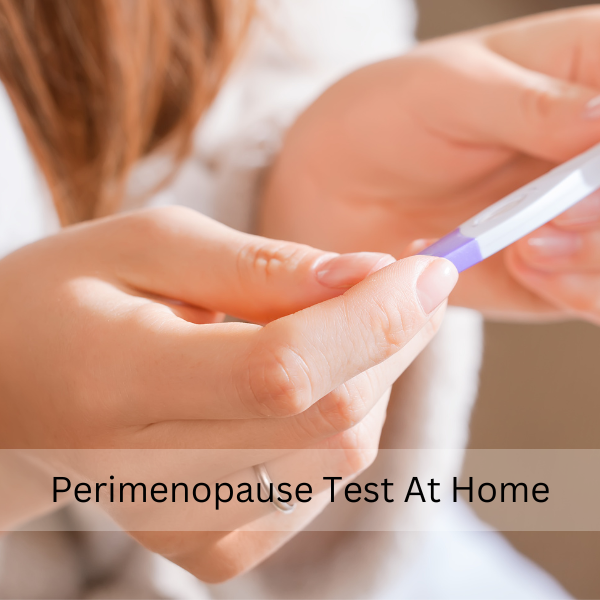How do cortisol and estrogen dominance impact each other? Learn how your stress hormone levels can affect your perimenopause experience.

What No One Tells You About Cortisol and Estrogen Dominance
Perimenopause is a significant transitional stage in a woman’s life that is often accompanied by lots of different symptoms and hormonal imbalances.
One important hormone that plays a key role during this time is cortisol, commonly known as the stress hormone. Cortisol, along with estrogen dominance, can contribute to a range of perimenopause symptoms and affect overall well-being.
In this article, we will explore the connection between cortisol and estrogen dominance in perimenopause and provide insights into hormone testing, imbalance treatment, and tips for managing adrenal health.
Understanding the interplay between cortisol and perimenopause, and in particular cortisol and estrogen dominance, can help you navigate this stage more easily, and that’s what this blog is all about!
Stages of Perimenopause
Perimenopause is the 2-8+ years before menopause, typically beginning in a woman’s 40s or 50s. During perimenopause, hormone levels, including estrogen and cortisol, start to fluctuate, signaling the approaching end of reproductive years.
Perimenopause can be divided into three stages (it is debatable whether it’s 2 or 3 stages)
- Early perimenopause: This stage is characterized by irregular menstrual cycles, with periods becoming shorter or longer. Some women may experience mild perimenopause symptoms such as insomnia, acne, and changes in mood.
- Mid perimenopause: In this stage, hormones continue to fluctuate, leading to more pronounced symptoms. Women may experience increased frequency and intensity of hot flashes, sleep disturbances, vaginal dryness, weight gain, and mood swings. Hormone balance becomes even more crucial during this stage.
- Late perimenopause: This stage is also known as the “menopausal transition,” as it is the final stage before menopause. Menstrual periods become sporadic or may stop altogether. Symptoms may peak during this stage due to declining estrogen levels. Women may experience more severe hot flashes, night sweats, weight gain, mood changes, and other perimenopause symptoms.
Understanding Perimenopause Symptoms
Perimenopause symptoms can vary from woman to woman, depending on factors such as genetics, lifestyle, and overall health. Hormonal imbalances, including both high estrogen and low estrogen and cortisol levels, can contribute to these symptoms. Common perimenopause symptoms include:
- Hot flashes: sudden, intense waves of heat and sweating, often accompanied by a flushed face and rapid heartbeat.
- Night sweats: sweating at night, often causing drenching of clothes or sheets; often starts in the chest and head
- Irregular menstrual periods: Changes in the frequency, duration, and flow of menstrual cycles. Could be close together or far apart, spotting or heavy, but typically represent a significant change from previous regular periods
- Mood swings and irritability: Fluctuating hormone levels can impact mood and emotional well-being, leading to mood swings, irritability, and anxiety.
- Insomnia and sleep disturbances: Difficulty falling asleep or staying asleep, waking up frequently during the night, particularly during the 2 a.m. to 4 a.m. timeframe.
- Vaginal dryness and discomfort: Decreased estrogen levels can cause vaginal dryness, itching, and discomfort during sexual intercourse.
- Changes in libido: Fluctuating hormone levels can affect sexual desire and arousal.
- Fatigue and low energy: Feeling tired and lacking energy, even after a full night’s sleep.
- Forgetfulness and difficulty concentrating: Hormonal changes can impact cognitive function, leading to memory lapses, brain fog and difficulty focusing.
Table: Perimenopause Symptom Comparison
| High Estrogen Symptoms (Estrogen Dominance) | Low Estrogen Symptoms | High Cortisol Symptoms | Low Cortisol Symptoms |
|---|---|---|---|
| Heavy or prolonged menstrual periods | Irregular menstrual periods | Weight gain, especially around the abdomen | Fatigue and low energy |
| Breast tenderness and swelling | Vaginal dryness and discomfort | Inability to relax and unwind | Difficulty managing stress |
| Mood swings and irritability | Hot flashes and night sweats | Insomnia and sleep disturbances | Hypotension (low blood pressure) |
| Weight gain, especially in the hips and thighs | Decreased libido | Anxiety and restlessness | Low immune function |
A balanced hormone level is super helpful for navigating perimenopause without big fluctuations in all of the above symptoms. Hormone testing can help identify estrogen and cortisol levels, allowing for targeted treatment and management of perimenopause symptoms.
What is Estrogen Dominance?
Estrogen dominance is a hormonal condition characterized by an imbalance between estrogen and progesterone levels in the body. When estrogen levels are too high relative to progesterone, it can lead to a range of symptoms and health issues.
Estrogen dominance can occur during perimenopause, or even before this, at any stage of a woman’s reproductive years. It’s most common in the first stage of perimenopause or if a woman has PCOS (polycystic ovarian syndrome).
Estrogen is an essential hormone for various functions in the body, including regulating the menstrual cycle, maintaining bone health, and supporting cardiovascular health. However, when estrogen levels become excessive, it can disrupt the delicate hormonal balance and lead to a lot of disruptive symptoms and conditions.

Symptoms and Causes of Estrogen Dominance
The symptoms of estrogen dominance can vary widely and may include:
- Irregular or heavy periods
- PMS-like symptoms
- Breast tenderness
- Weight gain, particularly around the hips and thighs
- Mood swings and irritability
- Low libido
- Insomnia
On the other hand, low estrogen levels can also cause symptoms such as:
- Hot flashes and night sweats
- Vaginal dryness
- Joint pain and stiffness
- Brain fog and memory problems
- Weakened bones
Several factors can contribute to estrogen dominance, including:
- Chronic stress, which can disrupt the balance between estrogen and progesterone
- Progesterone deficiency
- Poor gut health, which affects estrogen metabolism
- Liver dysfunction, leading to impaired estrogen detoxification
- Exposure to environmental toxins, such as certain plastics and pesticides, which mimic estrogen in the body
Understanding the symptoms and causes of estrogen dominance is the first step in identifying and addressing this hormonal imbalance. By addressing the root causes and rebalancing estrogen levels, women can alleviate their symptoms and improve their overall well-being.
What is Cortisol?
Cortisol is a hormone released by the adrenal glands in response to stress. It plays a crucial role in the body’s stress response system and helps regulate various physiological functions.
To better understand cortisol, it is essential to grasp its functions and effects on the body.
Functions of Cortisol
Cortisol has several important functions in the body, including:
- Regulating the body’s response to stress
- Controlling blood sugar levels
- Aiding in metabolism and energy production
- Regulating blood pressure
- Reducing inflammation
- Supporting the immune system
Effects of Cortisol
While cortisol is necessary for survival and maintaining homeostasis, chronically elevated cortisol levels can have detrimental effects on health. Prolonged stress and increased cortisol production can lead to:
- Suppressed immune function
- Impaired cognitive function and memory
- Inflammatory and autoimmune conditions
- Insulin resistance and weight gain
- Increased blood pressure
- Reduced bone density
- Impaired sleep quality
Cortisol regulation is essential for overall health and well-being. Proper management of stress and healthy lifestyle choices can help maintain optimal cortisol levels and support the body’s natural balance.
How Does Cortisol Relate to Estrogen in Perimenopause?
In perimenopause, the transition phase before menopause, the interplay between cortisol and estrogen levels is an interesting one. Hormonal fluctuations during perimenopause can lead to estrogen dominance, where estrogen levels are elevated compared to progesterone levels.
Cortisol, a stress hormone released by the adrenal glands, can significantly influence estrogen balance and contribute to estrogen dominance.
Cortisol, commonly referred to as the “stress hormone,” plays an important role in regulating the body’s stress response. During times of stress, cortisol levels rise to provide the body with the necessary energy to cope with the situation. However, chronic stress and prolonged elevation of cortisol can disrupt hormone balance and have detrimental effects on mood, inflammation, weight, risk for heart disease and other chronic diseases.
High cortisol levels in perimenopause can impact estrogen levels in several ways. Firstly, cortisol can inhibit the production and availability of progesterone, leading to an imbalance between estrogen and progesterone. This imbalance can result in estrogen dominance and contribute to symptoms such as weight gain, mood swings, and irregular periods.
Secondly, cortisol can interfere with estrogen metabolism. It can increase the conversion of estrogen precursors, such as androstenedione, to estrogen in peripheral tissues, further exacerbating estrogen dominance. This dysregulation of estrogen metabolism can lead to symptoms associated with high estrogen levels, including breast tenderness, bloating, and migraines.
Furthermore, cortisol can directly impact the hypothalamic-pituitary-adrenal (HPA) axis, a complex interaction between the brain and the adrenals involved in hormone regulation. Dysregulation of the HPA axis due to chronic stress and high cortisol levels can disrupt the normal feedback loop between the adrenal glands, hypothalamus, and pituitary gland, leading to further hormonal imbalances, including estrogen dominance.
Addressing cortisol levels and managing stress during perimenopause is essential for restoring hormonal balance.
Techniques for reducing cortisol and improving hormone regulation include:
- stress management strategies like mindfulness, cognitive behavioral therapy or other therapy techniques, meditation, deep breathing, (check out this link for my favorite stress management tool and save 25% on an annual subscription) earthing, and time spent in nature
- exercise (the most cortisol supportive exercises are yoga, pilates, walking, gentle strength training, cycling, hiking, and swimming)
- adequate sleep (goal is 7 to 9 hours of sleep, along with a consistent sleep and wake time)
- adopting a healthy lifestyle (eating low in added sugars and keeping your caffeine and alcohol intake to a minimum is super helpful)
Prioritizing self-care and seeking professional guidance can help control the impacts of cortisol on estrogen levels and promote overall well-being.
To illustrate the interplay between cortisol and estrogen in perimenopause, refer to the table below:
| Cortisol Levels | Estrogen Levels | Effects |
|---|---|---|
| High | Elevated | Estrogen dominance, weight gain, mood swings |
| High | Disrupted Metabolism | Breast tenderness, bloating, migraines |
| High | Dysregulation of HPA Axis | Further hormonal imbalances, estrogen dominance |
Best Ways to Test for Cortisol in Perimenopause
Accurate testing for cortisol levels is helpful for identifying imbalances and managing perimenopause symptoms. There are several effective methods available to test cortisol levels, specifically in the context of perimenopause. These include:
- DUTCH Test: The DUTCH (Dried Urine Test for Comprehensive Hormones) test is a comprehensive hormone testing method that analyzes cortisol and other hormone levels. It involves collecting dried urine samples over a 24-hour period to assess cortisol patterns throughout the day. This test offers valuable insights into cortisol metabolism and its relationship to other hormones.
- Saliva Cortisol Test: The saliva cortisol test measures cortisol levels in saliva samples collected at different times of the day. This test is convenient and non-invasive, allowing for multiple samples to be taken to assess cortisol rhythms. It provides information about the diurnal patterns of cortisol secretion and helps identify abnormalities in cortisol production.
- Blood Cortisol Test: The blood cortisol test measures cortisol levels in a blood sample. It is typically performed in a laboratory setting and provides information about total cortisol levels at a specific point in time. This test is useful for diagnosing conditions such as Cushing’s syndrome or Addison’s disease, but not as helpful to show cortisol patterns over several hours, and is not as accurate as saliva and urine testing.

When testing for cortisol in perimenopause, multiple factors must be considered, and a comprehensive approach must be used. Combining different testing methods can provide a more complete understanding of cortisol levels and their impact on overall hormonal health.
By taking a look at cortisol levels with your healthcare provider, you can assess hormone imbalances and tailor treatment plans to address specific needs. Testing for cortisol in perimenopause is an integral part of managing symptoms and promoting optimal well-being.
| Testing Method | Advantages | Disadvantages |
|---|---|---|
| DUTCH Test | – Provides comprehensive analysis of cortisol and other hormones – Assess cortisol patterns throughout the day |
– Requires collection of dried urine samples over a 17 to 20-hour period, as well as fluid restrictions before testing, and dietary restrictions |
| Saliva Cortisol Test | – Convenient and non-invasive – Allows for multiple samples to assess cortisol rhythms |
– Provides information on diurnal cortisol patterns but not the other supporting hormones and nutrients like the DUTCH test |
| Blood Cortisol Test | – Provides measurement of total cortisol levels at a specific point in time | – Requires blood sample collection in a laboratory setting and needle fear or pain may raise cortisol levels |
Best Ways to Test for Estrogen in Perimenopause
Testing for estrogen levels is helpful for diagnosing and managing estrogen dominance in perimenopause. Let’s explore some of the best ways to test for estrogen in perimenopause:
- Hormone Panels: Hormone panels provide a comprehensive assessment of hormone levels, including estrogen. This type of testing is often done through a blood sample and can give a detailed overview of estrogen levels and other hormone imbalances.
- Blood Estrogen Test: A blood estrogen test specifically measures the levels of estrogen in the bloodstream. Typically estradiol is tested
- Saliva Estrogen Test: Saliva estrogen testing is a non-invasive method for measuring estrogen levels. It provides a representation of the free, or bioavailable, estrogen in the body and can be helpful in assessing hormonal balance.
Consulting with a healthcare provider is recommended to determine which testing method is most appropriate for individual needs. In some cases, a combination of different tests may be recommended to gain a comprehensive understanding of estrogen levels and hormone balance.

How to Improve Your Cortisol Levels
Tips for Managing Stress and Balancing Cortisol
Managing cortisol levels is crucial for restoring hormonal balance and improving overall health. Excess cortisol, often caused by chronic stress, can disrupt the endocrine system and contribute to hormonal imbalances such as estrogen dominance. By adopting certain lifestyle changes and stress reduction techniques, you can effectively lower cortisol levels and support hormone balance during perimenopause.
One of the most effective ways to manage cortisol is through stress management techniques. Incorporating practices like meditation, deep breathing exercises, cognitive behavioral therapy or other therapy techniques, time spent outside like when earthing or doing nature walks, and yoga into your daily routine can help reduce stress levels and promote relaxation. These techniques have been shown to lower cortisol and alleviate symptoms associated with hormonal imbalance.
Regular exercise is another powerful tool for cortisol reduction. Engaging in physical activity, such as brisk walking, cycling, hiking, swimming, gentle strength training, yoga, pilates, or dancing, can help release endorphins, which act as natural stress reducers. Aim for at least 30 minutes of moderate exercise most days of the week to keep cortisol levels in check.
Additionally, making lifestyle changes that prioritize self-care and relaxation can have a significant impact on cortisol levels. Set aside time for activities that bring you joy and help you unwind, such as reading a book, taking a bath, journaling, gardening, enjoying your favorite hobby, getting a massage or spa treatment, or spending time with people who lift you up.
Prioritizing quality sleep is also crucial, as lack of sleep can elevate cortisol levels. Establish a bedtime routine, with consistent bedtimes and wake times, and create a sleep-friendly environment to ensure you get enough restful sleep each night.
FAQ
What is cortisol and estrogen dominance?
Cortisol is a hormone released by the adrenal glands in response to stress, while estrogen dominance is an imbalance between estrogen and progesterone levels. Estrogen dominance occurs when there is too much estrogen relative to progesterone in the body.
What are the stages of perimenopause?
Perimenopause is the transitional stage before menopause. It can be divided into three stages: early perimenopause, late perimenopause, and menopause transition. Specific changes in hormone levels and symptoms characterize each stage.
What are the symptoms of perimenopause?
Some common symptoms of perimenopause include irregular periods, hot flashes, night sweats, mood swings, vaginal dryness, and sleep disturbances. Hormonal imbalances, such as estrogen dominance and elevated cortisol levels, can contribute to these symptoms.
What are the symptoms and causes of estrogen dominance?
Symptoms of estrogen dominance include heavy or irregular periods, breast swelling and tenderness, mood swings, weight gain, and decreased sex drive. Possible causes of estrogen dominance include chronic stress, poor gut and liver health, exposure to environmental toxins, and progesterone deficiency.
What are the functions and effects of cortisol?
Cortisol plays a vital role in the body’s stress response, regulating blood sugar levels, metabolism, inflammation, and immune function. Chronic elevation of cortisol levels can lead to symptoms such as anxiety, weight gain, insomnia, weakened immune system, and hormonal imbalances.
How does cortisol relate to estrogen in perimenopause?
Cortisol can significantly impact estrogen levels in perimenopause. High cortisol levels can disrupt hormone balance and contribute to estrogen dominance. Cortisol also plays a role in hormone regulation and stress response during perimenopause.
What are the best ways to test for cortisol in perimenopause?
Several testing methods are available to assess cortisol levels, including the DUTCH test, saliva cortisol test, and blood cortisol test. These tests provide valuable insights into cortisol patterns, allowing for personalized treatment and management of perimenopause symptoms.
What are the best ways to test for estrogen in perimenopause?
Hormone panels, blood estrogen tests, and saliva estrogen tests are commonly used to measure estrogen levels in perimenopause. Regular monitoring of estrogen levels is crucial for diagnosing and managing estrogen dominance and ensuring hormone balance.
How can I improve my cortisol levels?
Managing stress is key to improving cortisol levels. Lifestyle changes such as practicing relaxation techniques, engaging in regular exercise, adopting a healthy diet, and prioritizing self-care can help reduce cortisol levels and restore hormonal balance in perimenopause.

Dr. Shelley Meyer is a board-certified family physician and Institute of Functional Medicine-certified functional medicine physician, as well as a Registered Dietitian. She is passionate about helping women navigate the roller coaster of perimenopause and postmenopause. She has her own Functional Medicine Practice in Denver, Colorado.




[…] Additionally, increased levels of cortisol, a stress hormone, during perimenopause can further exacerbate brain fog. Check out my blog on cortisol and estrogen dominance to find solutions to cortisol imbalance. […]